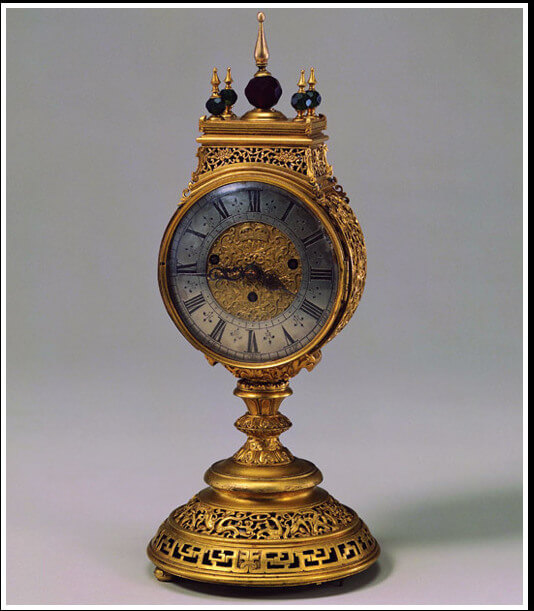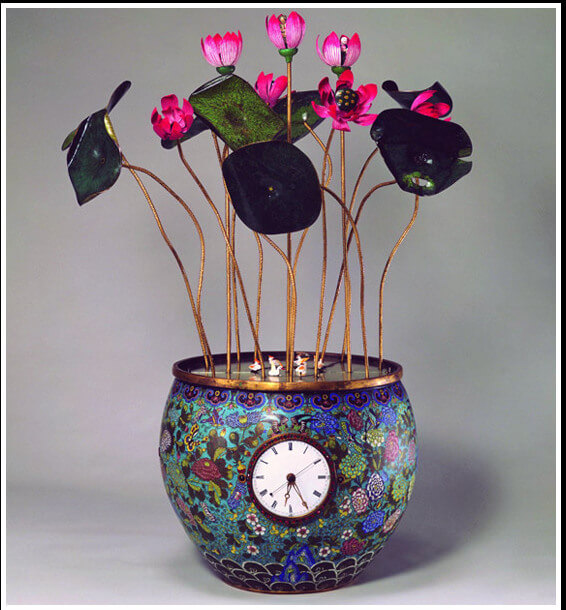After clocks had been introduced to the court of the Ming dynasty, the emperor enlisted the services of European missionaries who were familiar with such mechanisms and could ensure their day-to-day running and maintenance. During the Qing dynasty, emperors Shunzhi, who reigned from 1644 to 1661, Kangxi (1662-1722), Yongzheng (1723-1735) and Qianlong (1736-1795) each expressed great interest in and admiration for clocks. Successful imitations of Western clocks had been made even before Shunzhi’s reign, and so when emperor Kangxi acceded to the throne, the Forbidden City was already filled with clocks. At the same time, Europeans were asked to contribute their mastery of mechanical horology to improve the quality of Chinese-made clocks.
The proliferation of clocks at the imperial court was such that a Bureau of Chiming Clocks and a Bureau of Clockmaking were established. Emperor Kangxi, in the eleventh year of his reign (1671), had the words “Heavenly Veneration” inscribed on the southern facade of Duanning Hall. This was where the Bureau of Chiming Clocks could be found, dedicated to the conservation, repair and manufacture of clocks. In 1732, the tenth year of the reign of Emperor Yongzheng, the Bureau of Clockmaking was placed under the authority of the department with responsibility for the imperial workshops which produced, repaired, maintained and authenticated the clocks that were installed throughout the Forbidden City.
The Bureau of Chiming Clocks has remained in this location, where it stores clocks and other instruments of time measurement. At one time, the Hall of Fulfilled Wishes (Ruyiguan) in YuanMingYuan, the old summer palace, was home to the House of Clocks which assisted the Bureau of Clockmaking with its tasks. According to notes left by missionaries in the 1730s and 1740s, under the reign of Emperor Qianlong, the Palace’s clockmaking department employed a group of missionaries who were qualified in this art, Chinese craftsmen and eunuch-clockmakers. Some one hundred craftsmen in all were employed to make clocks for the emperor.
The imperial clocks
The 18th century was a time of great prosperity for Swiss and French watchmakers, and most of the missionaries who excelled in the manufacture of automata and mechanical clocks came from these two countries. They brought with them the latest Western techniques and, working alongside Chinese craftsmen and eunuchs, used their knowledge to elaborate the most famous Chinese clocks of that era. The Bureau of Clockmaking lived its golden age in the second half of the 18th century. Clocks made at that time were commissioned by the emperor, hence their name Yuzhi (made by order of the emperor). Commonly known as imperial clocks, they include many chiming clocks, artistic clocks, musical clocks, geng clocks and fob watches. They were produced with artisans from the other palace workshops, specialists in lacquer work, cabinetry, gold, jade and ivory carving, metalwork and gunsmithing. Any one of these objects could take several years to complete.
Chiming clocks sound the hours or the quarters. Large chiming clocks were made under the Qing dynasty, usually equipped with a lead pendulum and a gear-train transmission. The so-called artistic clocks were refined objects, widely used by the imperial family and high-ranking officials. One example is the “seigneurial clock in openwork gilded bronze” which incorporates a hat stand for a civil servant to use and the distinctive Qing dynasty insignia.

Musical clocks play a melody to mark the hour and, in certain cases, on demand. One such clock takes the form of “lotus in a bowl which open to reveal a peach.” It was assembled from a chased bronze bowl, crafted in the Province of Guangdong, and a musical mechanism from France. The clock set inside the bowl is the work of the Bureau of Clockmaking, as are the dancing lotus, and the carved ivory monkey, child and goddess Xi Wang-Mu (Queen Mother of the West) who are hidden inside the flowers. The Bureau also made the mechanism which opens the petals. Responding to the emperor’s wishes, Frère Valentin Chalier invented the geng clock. It displays Western time in periods of 12 and 24 hours, but also the five geng which are the Chinese divisions of the night. The length of each geng varies according to the length of the night which corresponds to the 24 solar periods of the traditional Chinese calendar.
The Clock and Watch Hall inside the Forbidden City
In the 1950s, a part of this collection of period clocks was presented in exhibition rooms within the Forbidden City. Later, in 1985, a Clock and Watch Hall was opened inside the Hall for Ancestral Worship (Fengxian Dian). It was entirely refurbished in October 2004, in keeping with its ranking among international watch museums. In addition to the exhibits of Chinese, English, French and Swiss clocks and watches, visitors can view documentary films and use the museum’s multimedia and research facilities. Currently, the museum presents over a thousand objects, the vast majority of which date from the 18th to the 20th centuries, the golden age of horology. The Forbidden City’s collection thus embraces 200 years of history, crowned by these clocks that were created for China and its emperors.












